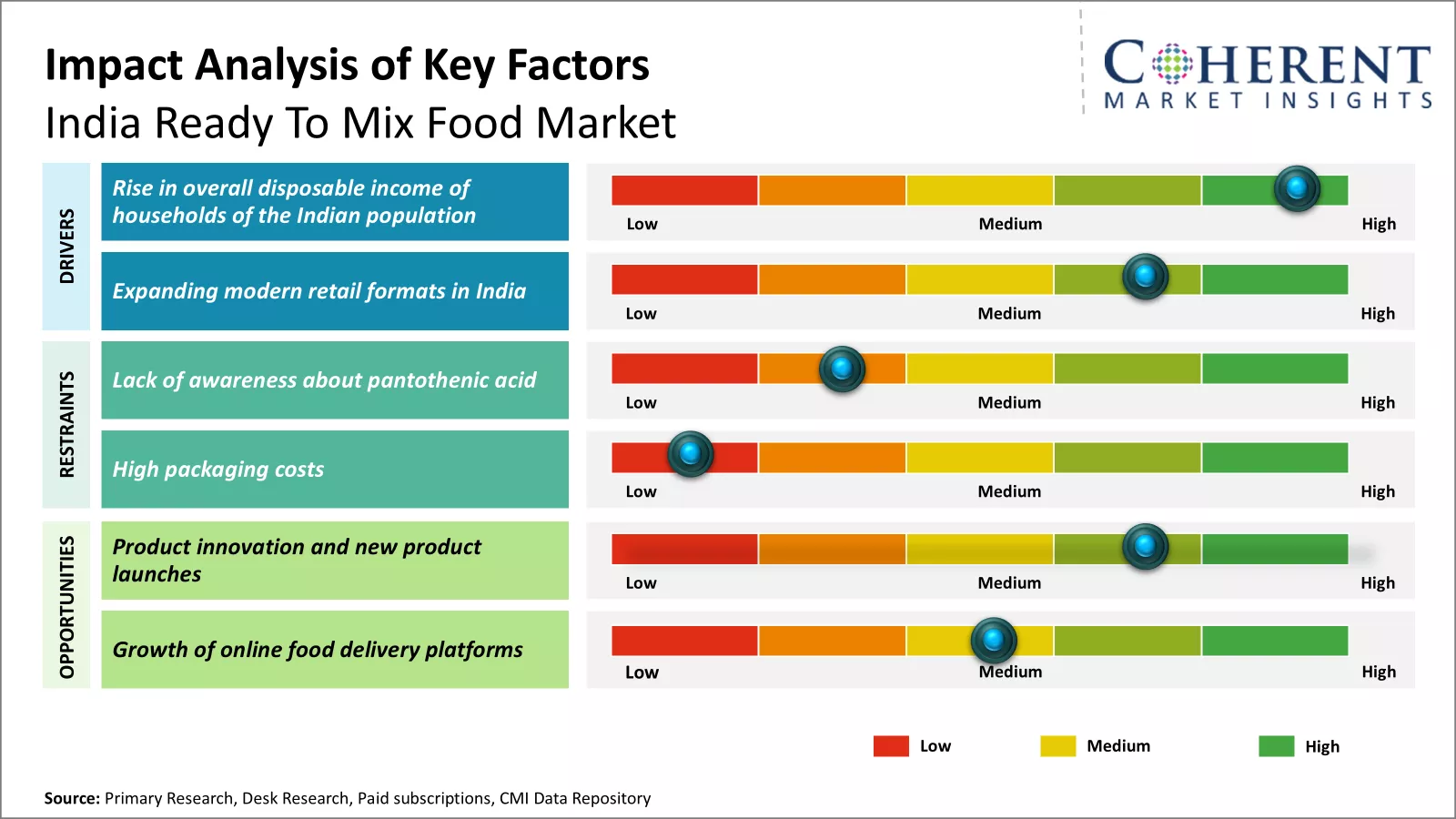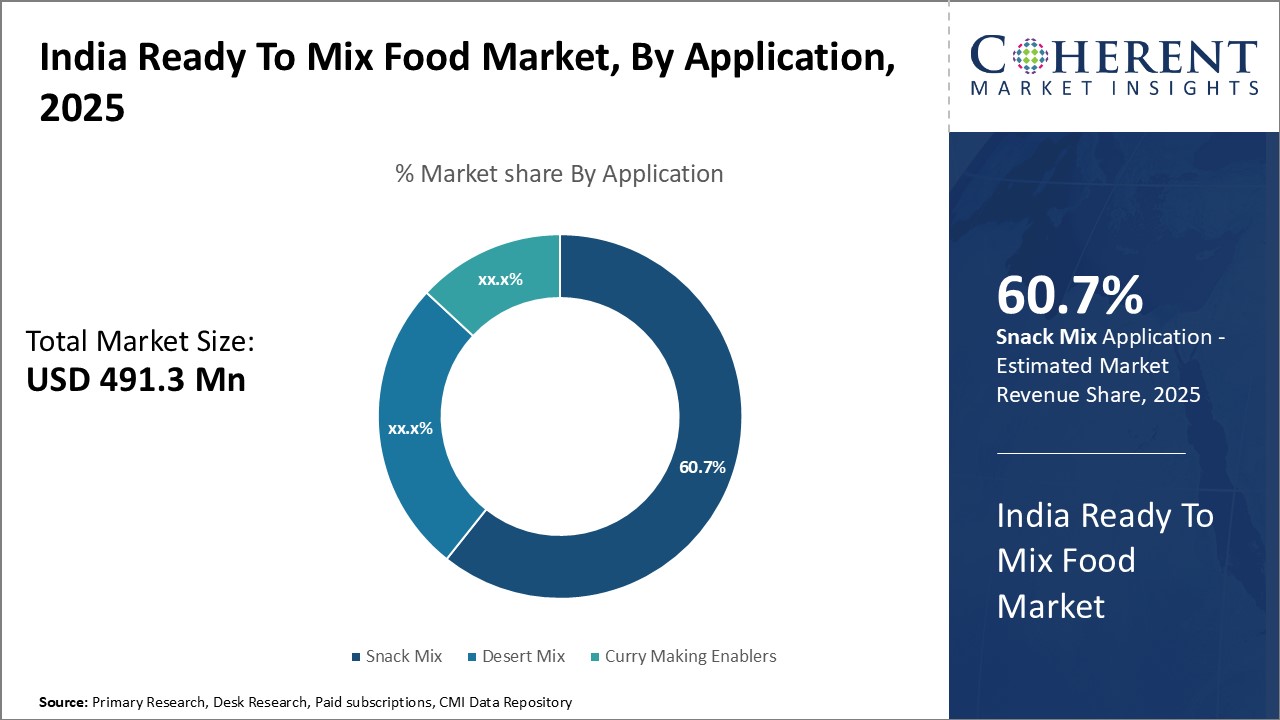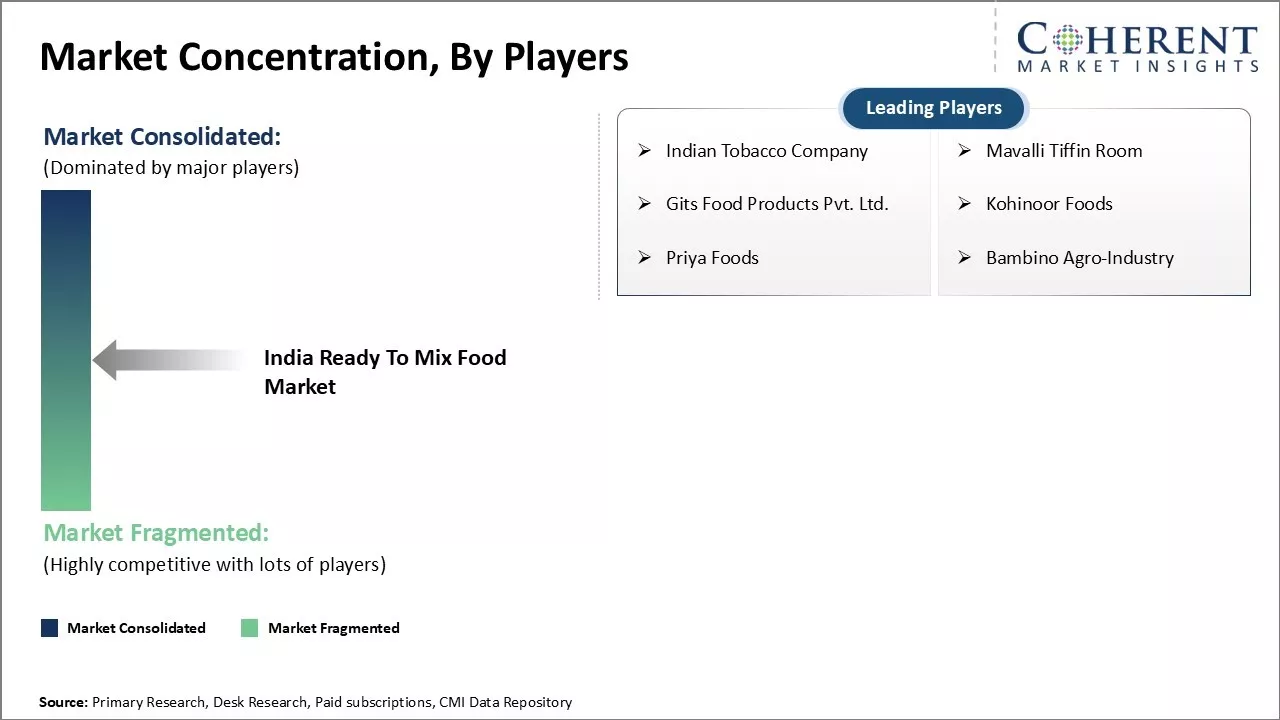The India ready to mix food market is estimated to be valued at USD 491.3 Mn in 2025 and is expected to reach USD 1,466.5 Mn by 2032, exhibiting a compound annual growth rate (CAGR) of 16.9% from 2025 to 2032. The market has been growing rapidly over the past few years due to rising income levels and changing lifestyles in India.

Discover market dynamics shaping the industry: Download Free Sample
India ready to mix food market in is expected to witness significant growth driven by increasing number of working women, changing food habits, and rising disposable income are expected to drive the sales of ready to mix food in India. Growing urbanization and nuclear families have further boosted the demand for convenient packaged foods like ready to mix foods and beverages in India.

Discover high revenue pocket segments and roadmap to it: Download Free Sample
Insights, By Application - Convenience and variety drive the snack mix segment
In terms of application, the snack mix segment is estimated to contribute the highest market share of 60.7% of the India ready-to-mix food market in 2025, owing to convenience and variety. As more Indians lead busy modern lifestyles with less time spent on cooking, they increasingly turn to ready-to-eat snack mixes for an easy, filling option. Snack mixes offer countless flavor combinations to satisfy different tastes from spicy to sweet. With ingredients like nuts, dried fruits, popcorn, baking bits, and seasonings premixed together, they eliminate the effort of measuring and combining components oneself.
Ready-to-eat snack mixes are also popular at social gatherings and parties as guests can casually graze on a variety of flavors without having to choose just one snack. Their packaging in resealable bags means portions can be finished over multiple sittings, reducing food waste. Especially outside major cities, ready-to-mix options have grown in demand as an alternative to deep-fried namkeen snacks. Many Indians also see them as a healthier indulgence compared to calorie-dense namkeens or processed chips.
Insights, by Distribution Channel - Supply chain’s Strength propels the Retail Segment
In terms of distribution channel, the retailers segment is estimated to contribute the highest market share of 32.7% to the India ready-to-mix food market in 2025, owing to their extensive supply chain reach. Traditional grocers and provision stores as well as modern retail chains stock a variety of popular ready-to-mix brands. Their wide networks ensure products are readily available throughout urban and rural areas. Proximity to consumers helps retailers quickly refresh stocks as needed.
Retailers' buying power allows them to procure items at competitive rates directly from manufacturers. This efficient supply chain helps keep products affordable for buyers. Strong relationships with suppliers also give retailers early insights into new launches, exclusives and promotions. Using their storefronts and distributor links, retailers execute impactful merchandising strategies from dedicated shelves to visibility-grabbing displays.
Well-resourced modern retail chains in particular promote ready-to-mix foods through bundled offers, combo packs, and tempting sampler units. Their loyalty programs and periodic discounts have boosted trial and repeat purchases. Traditional grocers leverage local community ties to spread awareness of new products through word-of-mouth. Overall, the extensive reach and operational smoothness of India's retail ecosystem make it the dominant and most prolific distribution system for ready-to-mix foods across the country.

Get actionable strategies to beat competition: Download Free Sample
Top Strategies Followed by India Ready to Mix Food Market Players
Established Players: R&D Investment: Leading companies in the India ready to mix food market heavily invest in research and development to introduce innovative products. For example, major players like ITC and Nestle spend over 5% of their annual revenues on R&D focused on enhancing nutritional value, shelf life, and taste of their ready to mix food products. This allows them to cater to evolving consumer preferences and needs.
Mid-Level Players: Cost-Effective Solutions: Medium-sized players in the market adopt strategies to deliver cost-effective product solutions. They focus on utilizing economical raw materials and optimized production processes to manufacture affordable ready to mix food options. This helps them target the price-sensitive segment and gain market share. For example, Akshay Foods introduces low-priced organic mixes for home cooking.
Small-Scale Players: Niche Specialization: Emerging small players leverage niche specialization as a key strategy. They launch specialized mixes targeting specific cuisine types, dietary needs or occasions. For instance, Tiny Chef caters to children with fun shapes and flavors in their mixes while Blendsify offers diabetic-friendly porridge mixes. This differentiation allows them to compete effectively against larger competitors.
Emerging Startups in the Industry
Innovative Technologies: Examples: Startups like Nutriart have developed smart jars that come equipped with sensors and connectors. These sensors monitor and report Inventory levels as well as track expiry and spoilage of the mix contents. This utilizes Internet of Things (IoT) to prevent food wastage.
Sustainable Solutions: Examples: Startups such as SouperNatural focus on sustainability by developing ready mixes made using surplus vegetables and fruits. They collect unsold produce from farms and transform them into eco-friendly mixes thereby reducing food waste. At the same time, their products are highly affordable.
Market Contribution: Niche Markets: Several startups address the needs of specific regional cuisines overlooked by major brands. For example, Raja Rasoi caters to North Indian niche with mixes for samosa, kachori, etc. while The Southern Staple Company offers South Indian staples like idli and dosa mixes.
Key Takeaways from Analyst
India Ready To Mix Food Market Report Coverage
| Report Coverage | Details | ||
|---|---|---|---|
| Base Year: | 2024 | Market Size in 2025: | USD 491.3 Mn |
| Historical Data for: | 2020 To 2024 | Forecast Period: | 2025 To 2032 |
| Forecast Period 2025 to 2032 CAGR: | 16.9% | 2032 Value Projection: | USD 1,466.5 Mn |
| Segments covered: |
|
||
| Companies covered: |
Indian Tobacco Company, Mavalli Tiffin Room, Gits Food Products Pvt. Ltd., Kohinoor Foods, Priya Foods, and Bambino Agro-Industry |
||
| Growth Drivers: |
|
||
| Restraints & Challenges: |
|
||
Uncover macros and micros vetted on 75+ parameters: Get instant access to report
Market Driver - Rise in overall disposable income of households of the Indian population
With India's economy experiencing steady growth in recent years, the overall disposable income of households has seen a considerable rise. This growth in disposable income has enabled Indian consumers to spend more on food as well as other items that were earlier considered as luxuries. Ready to mix food products find widespread acceptance among urban households that are dual income units and have less time to dedicate to cooking. For example, companies are introducing mixes for regional delicacies, gluten-free selections and mixes tailored for religious fasting periods. This has ensured the market remains relevant to all consumer segments. Efforts to make convenient cooking achievable for smaller households through affordable single-serve packaging is another observed trend catering to lifestyle changes. Their growing disposable income allows them to pay a premium for products that save time and efforts in the kitchen. Even families from middle income segments are willing to pay extra for Ready-to-Eat (RTE) foods as long as the value proposition justifies the higher price tag. Furthermore, single person households that comprise a notable percentage of the urban population rely heavily on ready meals as cooking for one tends to be inefficient.
Market Challenge - Lack of awareness about pantothenic acid
The India ready to mix food market faces significant challenges due to lack of awareness among consumers regarding pantothenic acid. Also known as vitamin B5, pantothenic acid plays a vital role in metabolism, and energy production. However, many Indians are still unfamiliar with the health benefits of pantothenic acid. As per the National Family Health Survey (NFHS) survey 2020-2021, over 50% of Indians suffer from deficiencies of one or more micronutrients including vitamin B5. Fortification of commonly consumed packaged foods could play a key role in filling this gap. However, lack of awareness acts as a hurdle for the industry in communicating the nutritional benefits of fortified products. This leads to lower demand for ready to mix food products fortified or enriched with pantothenic acid. Educating consumers about the important role of this vitamin can help address issues like fatigue, stress and weakness. However, consumer education requires extensive marketing campaigns which ready to mix food companies may not have the resources for. The challenge, therefore, is to create mass awareness in a cost-effective manner, perhaps through collaborative efforts between industry players, health organizations and the government. Overcoming this lack of awareness is critical for driving future growth in the India ready to mix food market.
Market Opportunity - Product innovation and new product launches
The India ready to mix food market presents significant opportunities for companies willing to innovate and launch new products. Consumer preferences are evolving rapidly in India with increasing health consciousness and experimentation with varied cuisine. Ready to mix food producers can leverage this by developing products aligned to popular diet trends like keto, paleo, and veganism. There is also scope to introduce mixes inspired from regional Indian cuisine beyond the usual North and South Indian options. Data published by Chef Hasti in October 2020, for example, the launch of multigrain dosa/idli mixes that allow for nutritious home-cooked South Indian snacks without the effort of grinding and fermentation has found popularity among urban youth and working professionals. Focusing on product variants tailored for different meal occasions like snacks and desserts will help drive higher consumption occasions. Companies can also enhance nutrient profiles and organically source ingredients to cater to premiumization demand. Adopting a constant new product development approach with specific focus on health, convenience and taste can deliver solid growth in the India ready to mix food market.
Share
Share
About Author
Yash Doshi is a Senior Management Consultant. He has 12+ years of experience in conducting research and handling consulting projects across verticals in APAC, EMEA, and the Americas.
He brings strong acumen in helping chemical companies navigate complex challenges and identify growth opportunities. He has deep expertise across the chemicals value chain, including commodity, specialty and fine chemicals, plastics and polymers, and petrochemicals. Yash is a sought-after speaker at industry conferences and contributes to various publications on topics related commodity, specialty and fine chemicals, plastics and polymers, and petrochemicals.
Missing comfort of reading report in your local language? Find your preferred language :
Transform your Strategy with Exclusive Trending Reports :
Frequently Asked Questions
Joining thousands of companies around the world committed to making the Excellent Business Solutions.
View All Our Clients